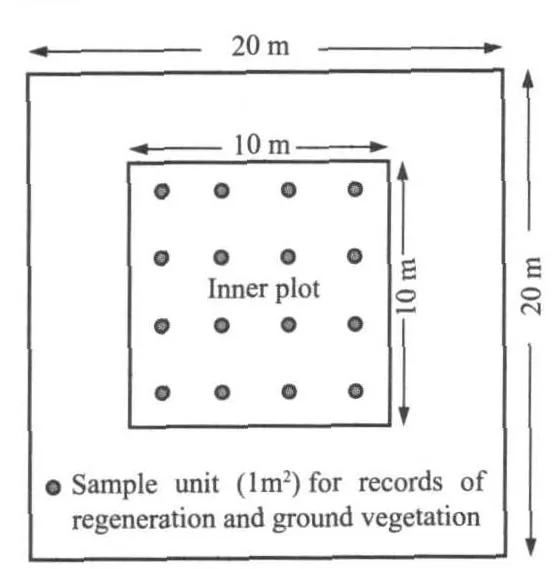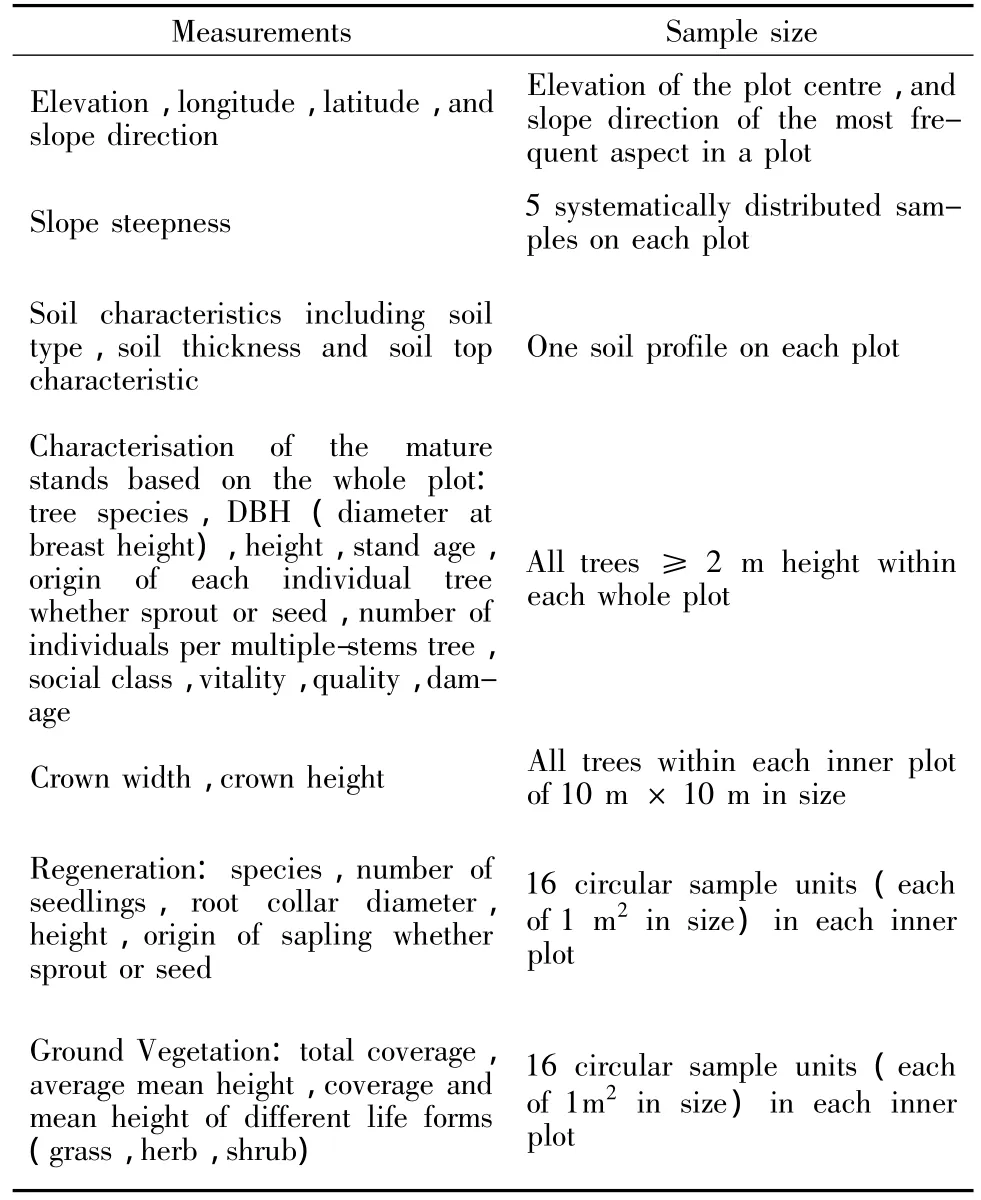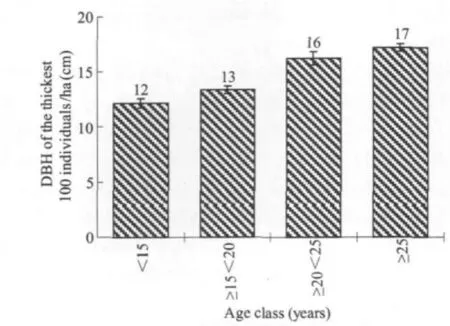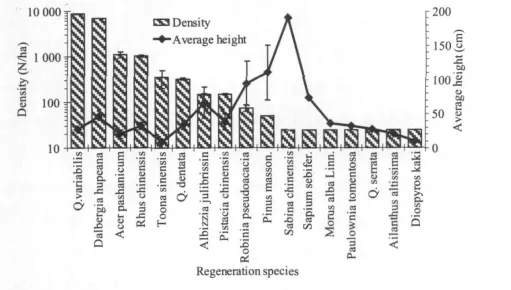Assessment and Management of Oak Coppice Stands(Quercus variabilis)in Shangnan County,Southern Shaanxi Province
2012-11-13XiaolanWangHanyElKatebBernhardFelbermeierPingcangZhangReinhardMosandl
Xiao-lan Wang,Hany El Kateb,Bernhard Felbermeier,Ping-cang Zhang,Reinhard Mosandl
(1.Institute of Silviculture,Technische Universität München,85354 Freising,Germany;2.Soil and Water Conservation Department,Yangtze River Scientific Research Institute,Wuhan 430010,China)
1 Introduction
Quercus variabilis(Chinese cork oak)is considered as one of the major tree species in the warm-temperate deciduous broad-leaved forest and subtropical evergreen broad-leaved forest.It is widely distributed in Asian countries,as Japan,Korea and China.In China,the Qinling Mountain in the Shaanxi Province and the Dabieshan Mountain in the Anhui Province are the major distribution areas[1].Quercus variabilis can be found in these areas at an elevation ranging from 500 to 1 600m above sea level.In the Qinling Mountain,the Quercus variabilis high forests are distributed between 1 200and 1 600m above sea level,while the major area of the Quercus variabilis forest is stocked at lower elevations ranging from 500and 1 200m above sea level[2].However,due to the excessive exploitation and inappropriate management,most of the former volume-rich-oak stands occurring in the low mountainous areas became oak coppices,characterized by sprouting regeneration.
Since the 1970s,several studies on Quercusvariabilis have been conducted due to its high timber value and importance for soil and water conservation aspects[3-4].Population dynamics and species spatial distribution pattern were studied in different regions of the Shaanxi Province[5-7].Zhang and Lu,2002[8]classified the Quercus variabilis communities in the Shaanxi Province into six types,for each,the species’diversity was investigated.Some models were developed to describe the dynamic of the age structure of Quercus variabilis population[6].Furthermore,the impact of climate change on the physiological characteristics of seedlings was investigated[9-10].Zhang etal.,2003[9]found significant difference in drought resistance in four Quercus variabilis provenances.Yi etal.,2008[10]proved that the photosynthesis of the cork oak was negatively affected under waterlogging condition.
As Chinese cork oak was considered as an important reforestation tree species,attention had been given to silvicultural techniques that improve its survival rate in open fields[11-13].The biomass of the Chinese oak was discussed in several studies[14-15].Management systems to improve stand stability and productivity in North China were recommended by Zhang,2000[16]and Lu,2007[17].Zhao etal.,2008[18]recommended the selection of potential crop trees for the management of the cork oak plantations.However,few studies regarding the management and regeneration ability of oak forests were carried out in the Shaanxi Province.In addition,most of the studies dealing with Quercus variabilis focused on basic research rather than management aspects[5-7].
Shangnan,as one of the catchment areas of the Danjiang River,plays an important role on soil and water conservation.The implementation of the South-North Water Diversion Project gave even more attention to this area.Quercus variabilis is the main deciduous tree species in Shangnan.It is widely used by the local residents for e.g.,firewood,materials for planting mushroom and housing construction.However,there is a lack of knowledge about how best the oak coppices can be managed.
The present study is a part of the Sino-German project“Rehabilitation of degraded land ecosystems in the mountainous area of the Southern Shaanxi Province,China”[19],which is a joint research project between the Institute of Silviculture at the Technische Universität München,Germany,and the Soil and Water Conservation Department of Yangtze River Scientific Research Institute,China.The objective of the present study is to provide recommendations for the sustainable management of oak coppice by 1)scientific investigation of the potential of the coppice stands in regard to the wood production and stand regeneration and by 2)the assessment of the degree of acceptance by the local inhabitants to change the traditional use of the forest resources.
2 Materials and methods
2.1 Study area
The present study is conducted in the Shangnan County,Southern Shaanxi Province,China(33°06'-33°44'N and 110°24'-111°01'E).The Shangnan County is located in the eastern Qinling Mountain.The Danjiang River,a branch of the Hanjiang River,forms the largest watershed in this county.Mean annual temperature varies between 10.7-15.0℃,and mean annual rainfall is 800mm.The whole county is situated in the transitional area of subtropical zone and warm temperate zone.Rich vegetation resources are established in this region.Forest vegetation covers62%of the area which is mostly dominated by oak and pine(Pinus massoniana Lamb and Pinus tabulaeformis Carr.).The oak stands are mainly composed of Quercus variabilis mixed with Quercus acutissima,Quercus dentata and Quercus serrata Murray(Zhang,1986).
2.2 Sampling procedure
The assessment of oak coppices is based on 30 sample stands in the Shangnan County.These stands were randomly selected within an area of a size of 20km×20km(33°26'27″-33°37'15″N and 110°43'22″-110°56'10″E),which includes two main branches of the Danjing River(Qingyou and Xian).Using a topographic map,watersheds within the 400km2area were identified,whereas larger watersheds were partitioned in smaller units not exceeding 4km2.From these units,which in total make 72,ten were randomly selected.In the field,each selected unit was identified using GPS(global positioning system).Within each of the selected units,three stands were selected in turn.The selection was based on identifying a starting walking direction.So,one from eight directions was selected at random.The first stand was the one found in the walking direction from the starting point.Following the same direction,providing a distance of at least 200m,the next two stands were selected.This sampling procedure was appropriate,as too long walking distances could be avoided.
In each selected stand,a plot of 20m×20m in size was established for the data collection of the mature stands.Each plot includes an inner plot of 10m×10m,on which 16 circular sample units of a size of 1m2were systematically installed.These were used to collect information about the regeneration and the ground vegetation.The layout of a plot is presented in Fig.1.
2.3 Data collection
The data were collected in summer,2008.A brief description of the investigated parameters is presented in Table 1.

Fig.1 Layout of a plot

Table 1 Data collection in the coppice stands
2.4 Socioeconomic survey
A socio-economic questionnaire was conducted in summer 2009 on randomly selected 175 households from11 villages.These villages were located within the Shangnan County.The farthest one was 19km and the nearest one was 5km away from the county centre.A list of questions,focusing on the oak coppices usage,was introduced to the head of each selected household.It includes information about the land use,usage of timber and non-timber products, energy sources,knowledge about the hazard of inappropriate land use and soil and water conservation measures,efficiency of collaboration with local authorities,and other social and environmental aspects.The questions were explained to each interviewee to avoid any misunderstanding and to improve efficiency of answers during the interview.
3 Results
According to the results of the survey,the age of the selected stands varied between 10and 25 years.25 stands from the selected 30,which make 83%of the total coppiced stands were mixed stands dominated by Quercus variabilis.The remaining 17%of the stands,which are not presented here,were dominated by Quercus acutissima.There was no indication for any limitation of the distribution of the Quercus variabilis by the prevailing site conditions in the study area(Table 2).
The results of some stand characteristics of the selected stands are presented in Fig.2.The multiplestems coppiced stands are dense in number reaching in average over 5 700 individuals/ha at the young age class(<15 years)and 2 100 stems/ha in average at the stands older than 20 years.The stocking capacity reaches 120m3/ha in average at the older age classes(≥25 years)even after frequent timber harvest.Moreover,the arithmetic mean of the diameter at breast height(DBH)is not reduced.Fig.3 shows the average DBH of the thickest 100 individuals/ha.It can be seen that vigorous individuals at different ages are available in the coppice stands indicating a high potential for productivity.
Within a survey area of 400m2in all the studied Quercus variabilis coppice stands,17 different woody

Table 2 Some site characteristics of the selected Quercus variabilis stands

Fig.2 Arithmetic means of the density,volume,and DBH(diameter at breast height)of Quercus variabilis at different age classes in the study area

Fig.3 Arithmetic mean of the DBH(diameter at breast height)of the thickest 100 individuals of Quercus variabilis per hectare at different age classes
species were found in the understory regeneration(Fig.4).Many of these species are of ecological and economical importance,as Quercus variabilis,Q.dentata,Dalbergia hupeana,Pistacia chinensis,and Rhus chinensis.The average number of the understory species in a stand was 3.3±0.3 in 16m2.The average density of the natural regeneration in a stand reached up to 19 000±133 individuals/ha with an average height of 35 ±3.0cm.The average height of the different species of the understory regeneration in the study area is indicated in Fig.4.

Fig.4 Arithmetic means of the density and height of the understory regeneration in the Quercus variabilis coppice stands in the study area
4 Management options
The results revealed that the cork oak coppices stands in the study area have a high productive potential.In addition,the understory regeneration is sufficient in density and consists of diverse valuable nativespecies.This provides the possibilities for many options that can be practiced towards sustainable management of such stands.The following three forest systems[20]are appropriate for the prevailing situation in the study area.
Coppice:Coppicing is the cutting of trees back to ground level on a regular short rotation[21].Where the stands are not degraded,which means the re-growth of the coppiced trees is still rapid and not diminished by overharvest or due to root aging,the traditional management being coppice can be practiced.This supports the local farmers of using the harvested wood as fuel,fencing material and for mushroom cultivation.
Coppice with standardsis an appropriate option to form two-story,uneven-aged forests,where suffi-cient standards or large trees with good quality are available in the coppice stands[22-23].The standards are selected and spaced out to stimulate their growth till they grow into the desired large timber.This timber is used for construction and furnisher.The cut small trees to promote the growth of the standards are used as fuel wood or material for mushroom cultivation.In the open patches arisen by the cutting of the small trees,the growth of the understory regeneration is stimulated by the available high light intensity and,thus,the production of timber and non-timber products is substantially supported.
High forest:Where the coppice stands are degraded or the re-growth of the coppiced trees is slow but sufficient natural regeneration is available on the forest floor,the stands can be converted to high forest for the production of valuable timber.Intense thinning or gap opening is then applied to promote the growth of the understory regeneration.The high light intensity at the forest floor will accelerate the production of timber and non-timber products.On the long-run the promoted regeneration will replace the former coppice stands and develop to high forest.The valuable wood can be used for construction,furnishing and veneer.Transition of coppice to high forest can also be initiated by means of artificial regeneration(i.e.,direct seeding or planting immediately after thinning)in the event of insufficiency of natural regeneration in the coppice stands.
All the above-described management options maintain a continuous forest cover,which supports the objectives of soil and water conservation.The recommendation of Zhang etal.,2008[24]to protect the Quercus variabilis stands at low altitudes is not valid for the study area due to high demand for timber by the local residents and the ecological as well as the economical benefits of managing those coppice stands in a sustainable way.
The results of the socioeconomic study show a high degree of acceptance among the local inhabitants(79%of the total households)to change traditional land use,providing an enhancement of their economic situation.The further analyses of the stands assessment and the socioeconomic survey will enable the development of recommendations not only to improve the environmental situation and the land use management,but also to satisfy the desires of the local rural residents,in particular to their economic income,subsequently improving their living standards.
The present study was conducted within the framework of the Sino-German project“Rehabilitation of degraded land ecosystems in the mountainous area of the Southern Shaanxi Province,China”.Support of this work was provided by the BMBF(German Federal Ministry of Education and Research),the Soil and Water Conservation Department of Yangtze River Scientific Research Institute,and the Robert Bosch Foundation,to whom we would like to express our gratitude.We owe also the DAAD(German Academic Exchange Service)a great appreciation for providing a Doctoral Grant for the proceeding author.
[1]吴明作.栓皮栎研究进展[J].陕西林业科技,1998,(4):65-69.(WU Ming-zuo.Research Status on Quercus variabilis[J].Shaanxi Forest Science and Technology,1998,(4):65-69.(in Chinese))
[2]张仰渠.陕西森林[M].西安:陕西科学技术出版社&中国林业出版社,1986:235-240.(ZHANG Yangqu.Shaanxi Forest[M].Xi’an:Shaanxi Science Technology Press& China Forestry Publishing House,1986:235-240.(in Chinese))
[3]魏 林.栓皮栎分布的初步调查[J].林业科学,1960,(1):70-71.(WEI Lin.Preliminary Investigation on Distribution of Quercus variabilis[J].Forest Science,1960,(1):70-71.(in Chinese))
[4]吴云汉,姚占芳.栓皮栎、麻栎枝条粉碎栽培香菇试验[J].河南农业大学学报,1990,(3):374-376.(WU Yun-han,YAO Zhan-fang.A Planting Mushroom Experiment Used Cork Oak Branches as Material[J].Journal of Henan Agricultural University,1990,(3):374-376.(in Chinese))
[5]张文辉,卢志军,李景侠,等.陕西不同林区栓皮栎种群空间分布格局及动态的比较研究[J].西北植物学报,2002,22(3):476-483.(ZHANG Wen-hui,LU Zhi-jun,LI Jing-xia,etal.A Comparative Study on Spatial Distribution Pattern and Its Dynamics of Quercus variabilis Populations Among Different Forest Areas in Shaanxi Province,China[J].Acta Botanica Boreali-Occidentalia Sinica,2002,22(3):476-483.(in Chinese))
[6]韩照祥,张文辉,李军乔,等.陕西不同地区栓皮栎种群年龄结构动态模型的研究[J].西北植物学报,2004,24(2):254-258.(HAN Zhao-xiang,ZHANG Wen-hui,LI Jun-qiao,etal.Study on Dynamics Model of Age Structure of Quercus variabilis in Different Region in Shaanxi[J].Acta Botanica Boreali-Occidentalia Sinica,2004,24(2):254-258.(in Chinese))
[7]韩照祥,张文辉,山 仑,等.陕西地区栓皮栎种群统计特征的区域变异性研究[J].干旱区资源与环境,2004,18(3):148-153.(HAN Zhao-xiang.ZHANG Wen-hui,SHAN Lun,etal.Study on Area Variability of Quercus variabilis Population’s Demography Characteristics in Shaanxi Region[J].Journal of Arid Land Resources and Environment,2004,18(3):148-153.(in Chinese))
[8]张文辉,卢志军.栓皮栎种群的生物学生态学特性和地理分布研究[J].西北植物学报,2002,22(5):1093-1101.(ZHANG Wen-hui,LU Zhi-jun.A Study on the Biological and Ecological Property and Geographical Distribution of Quercus variabilis Population[J].Acta Botanica Boreali-Occidentalia Sinica,2002,22(5):1093-1101.(in Chinese))
[9]张文辉,段宝利,周建云,等.不同种源栓皮栎幼苗水分适应及耐旱特性比较研究[J].西北植物学报,2003,23(5):728-734.(ZHANG Wen-hui,DUAN Bao-li,ZHOU Jian-yun,etal.A Comparative Study on Characters of Drought Resistance for Four Provenances of Quercus variabilis[J].Acta Botanica Boreali-Occidentalia Sinica,2003,23(5):728-734.(in Chinese))
[10]衣英华,樊大勇,谢宗强,等.模拟淹水对枫杨和栓皮栎气体交换,叶绿素荧光和水势的影响[J].植物生态学报,2008,28(12):6025-6033.(YI Ying-hua,FAN Da-yong,XIE Zong-qiang,etal.The Effects of Waterlogging on Photosynthesis-Related Eco-Physiological Processes in the Seedlings of Quercus variabilis and Taxodium ascendens[J].Journal of Plant Ecology,2008,28(12):6025-6033.(in Chinese))
[11]王九龄.北方石质低山阳坡造林的好树种-栓皮栎[J].林业实用技术,1975,(8):6-8.(WANG Jiuling.Quercus variabilis,One Excellent Afforestation Tree Species in Boreal Area[J].Forest Science and Technology,1975,(8):6-8.(in Chinese))
[12]郑均宝,于 力,王德艺.影响栓皮栎等造林成活因素的研究[J].河北林学院学报,1990,(1):33-38.(ZHENG Jun-bao,YU Li,WANG De-yi.Study on Factors Influencing Forestation Survival Rate of Oriental Oak(Quercus variabilis Bl.)[J].Hebei Journal of Forestry and Orchard Research,1990,(1):33-38.(in Chinese))
[13]张理宏.栓皮栎扣杯直播造林技术[J].林业科技通讯,1992,(4):28-30.(ZHANG Li-hong.Afforestation Technique of Quercus variabilis[J].Forest Science and Technology,1992,(4):28-30.(in Chinese))
[14]鲍显诚,陈灵芝,陈清朗,等.栓皮栎林的生物量[J].植物生态学与地植物学丛刊,1984,(4):313-320.(BAO Xian-cheng,CHEN Ling-zhi,CHEN Qing-liang,etal.The Biomass of Planted Oriental Oak(Quercus variabilis)Forest[J].Journal of Plant Ecology,1984,(4):313-320.(in Chinese))
[15]刘玉萃,吴明作,郭宗民,等.宝天曼自然保护区栓皮栎林生物量和净生产力研究[J].应用生态学报,1998,9(6):569-574.(LIU Yu-cui,WU Ming-zuo,GUO Zong-min,etal.Biomass and Net Productivity of Quercus variabilis Forest in Baotianman Natural Reserve[J].Chinese Journal of Applied Ecology,1998,9(6):569-574.(in Chinese))
[16]张文东.提高栓皮栎林分经营效益的技术实践[J].山西林业,2000,(5):26.(ZHANG Wen-dong.Practical Techniques to Improve the Management Efficiency of Quercus variabilis[J].Forestry of Shanxi,2000,(5):26.(in Chinese))
[17]卢彦昌.不同经营措施对栓皮栎群落稳定性的影响[D].陕西杨凌:西北农林科技大学,2007.(LU Yanchang.Effect of Community Stability of Quercus variabilis with Different Managing Measures[D]. Yangling,Shaanxi:Northwest Agricultural& Forestry University,2007.(in Chinese))
[18]赵浩彦,陆元昌,宁金魁,等.北京栓皮栎林分的干形质量初步研究[J].林业资源管理,2008,(1):44-48.(ZHAO Hao-yan,LU Yuan-chang,NING Jinkui,etal.Primary Study on Stem Quality of Cork Oak(Quercus variabilis Blume)Plantations[J].Forest Resources Management,2008,(1):44-48.(in Chinese))
[19]EL KATEB H,FELBERMEIER B,ZHANG P C,etal.Rehabilitation of Degraded Land Ecosystems in Southern Shaanxi Province:An Introduction to a Sino-German Project[C]∥German Federal Ministry of Education and Research(BMBF).ERSEC International Conference in Beijing,P.R.China.October 8-10,2008.
[20]IUFRO.SilvaVoc Terminology Project[EB/OL].(2005-11-01)[2011-04-01].http://www.iufro.org/science/special/silvavoc.
[21]BUCKLEY G P.Ecology and Management of Coppice Woodlands[M].London:Chapman & Hall,1992.
[22]MACHAR I.Coppice-with-Standards in Floodplain Forests-A New Subject for Nature Protection[J].Journal of Forest Science,2009,55(7):306-311.
[23]GROSSP,KONOLD W.The“Mittelwald”:An Agroforestry System Between Rigid Sustainability and Creative Options.A Historical Study[J].Allgemeine Forst Und Jagdzeitung,2010,181(3/4):64-71.
[24]张文辉,卢彦昌,周建云,等.巴山北坡不同干扰条件下栓皮栎种群结构与动态[J].林业科学,2008,24(7):11-16.(ZHANG Wen-hui,LU Yan-chang,ZHOU Jian-yun,etal.Population Structure and Dynamics of Quercus variabilis in Different Habitats on Northern Slope of Bashan Mountain[J].Scientia Silvae Sinicae,2008,24(7):11-16.(in Chinese))
